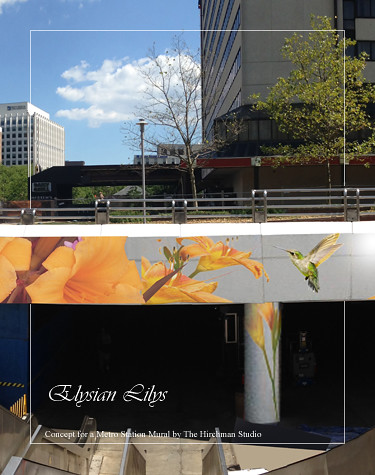
Volume XVII, Issue VII
Murals for Public Spaces
Harry Weese actually created the spaces of Washington’s Metro as a Brutalism/Minimalist statement. He specified that their be no murals, but four decades later the imposing fearsomeness of the spaces had the leadership of Bethesda, Maryland creating public art.
Was it successful? Our studio submitted a very natural floral mural... a continuation of the theme began in the Hollyhocks Mural in Charlottesville. Our goal was indeed to overlay the stark entrance/bus shed with a natural imagery to create an inviting space. I joked to my colleagues: “This won't win. Bethesda Arts likes stark geometrics.”
Sure enough, the winning design was stark and geometrical. Though it has vibrant colors and is a good mural, it's Mayan hyroglyphs read to some people more like a diagram of underground utility piping. Not exactly the way to make the space more inviting unless the artist is David McCauley. Here are some interesting comments from the article that follows:
Let’s Cover Blank Walls with Public Murals
By Dan Malouff
[click to read]
One of the most basic tenets of good urban design is that walkways should be lined with things to look at. Blank walls discourage walking because they make a walk seem boring and therefore longer, and because empty and lightly maintained spaces feel less safe. Detailed, colorful places are inherently more pedestrian friendly than dismal, blank spaces, and therefore urbanistically superior. So, given that, why do we accept so many blank spaces in our cities? (read more)
Scott on February 3, 2017 at 8:02pm
One man's art is often another man's grafitti. The original design for the Metro by Harry Weese specifically excluded art to avoid the discussion of what is appropriate and what is not. Have you all seen the awful mural that was added at the Bethesda Metro Station? I even like modern art, and this thing just looks bad, and is not good urban streetsscape design. Public art and heroic sculpture is a great idea if well done, but I have seen some very bad and tasteless artwork in public places.
Another topic is the fine line between thoughtfully commissioned murals and illegal vandalism. It really is difficult to enrich the public realm without offending at least some of the public. I vote for great lighting, interesting textures, useful way finding signage, even some bright colors but suggest that unless art is carefully curated, we should avoid filling our city with poorly conceived murals.”
John D on February 5, 2017 at 11:22am
I have to agree that the mural at the Bethesda Metro Station is spectaculary awful. it's easy to visualize alternatives for that space that would be simpler, more durable, and more complimentary to its environment. So if that's an example of what we might get, I'd have to vote for more advertising to fund the system, too. At least ads get vetted by someone's marketing department and has to meet a quality hurdle.”
At this point, I want to emphasize that having designed a mural concept for the space, I can say flat-out that it is a difficult space. The bus shed is awkward in scale and the Metro escalator is long and scary. I noticed many able-bodied people opting for the elevator. I rode that escalator a number of times to get a sense of the sequence one went through going to Metro.
I rode down as a man and his girlfriend (or wife) descended in front of me. She was laden with packages and he, carrying nothing, followed her down. I slipped down the left side and placed myself in front of the woman, simply because Southern men are taught from childhood to place themselves between women and danger. I rode down the long escalator standing there. The old escalator gave a rather wobbly ride and I thought of how one of these Metro escalators had actually failed – freewheeling down during a day when hundreds of thousands visited Washington for a Pro-life Rally on the mall.
The media was often guilty of downplaying the numbers of Pro-life Rallys, so as the official ridership of the day became public record as part of the investigation, it was shown that there are a lot more people riding the Metro on a day when there’s a Pro-Life Rally than the media would like to admit. Thankfully there were only minor injuries and the most harrowing image of the day was that of crushed baby strollers. I would call it a miracle.
But back to the rude man and the laden lady -- That little moment convinced me that bringing beauty and nature into the space might be a very good thing. I wanted at that point so desperately to break the spell of that dirty brutalist space... but it was not to be. About forty of us were competing for the opportunity and the $30,000 muralist's fee. I was able to see some of the other entries. There were quite a few geometric designs (design to competition committee), and I liked many of them more than the winning design.
In the end I was satisfied that I had created a good solution and that on another day another committee might have wanted something ‘different.’ But this time the committee opted for what they had financed earlier in a retaining wall mural.
I called my concept Elyssian Lilys. It was a continuation of a theme that begins with my old assistant Kristina’s Great, Great Grandmother’s Hollyhocks, which return every year to bless the street where they were planted long ago even though the house is long gone. It is also a tribute to a friend’s daughter, Lily. I had done a smaller mural of Heavenly Hollyhocks in the Fifeville Neighborhood of Charlottesville, Virginia. It warmed what had been a rather stark entry to a beauty salon and that exercise proved to me and those acting as design critics: Kristina Elaine Greer and Lisa Johnson, that a large natural element might indeed create a welcoming environment overlayed on Weese’s Brutalism and was sufficient in contrast so as not to take much away from it.
I think it will find a good home in urban fabric someday.
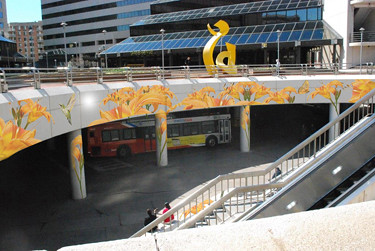

A Floral Legacy
The Springhill Hollyhocks
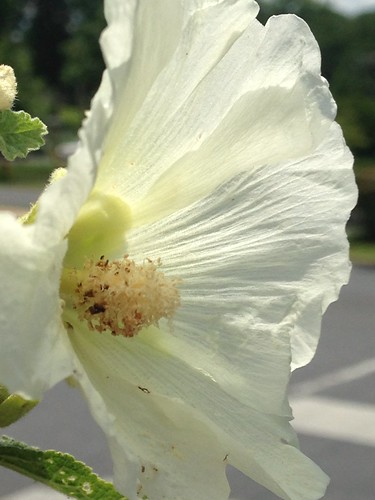
White Hollyhock, Springhill Road. Photo by Bob Kirchman
Everyone must leave something behind when he dies, my grandfather said. A child or a book or a painting or a house or a wall built or a pair of shoes made. Or a garden planted. Something your hand touched some way so your soul has somewhere to go when you die, and when people look at that tree or that flower you planted, you're there. It doesn't matter what you do, he said, so long as you change something from the way it was before you touched it into something that's like you after you take your hands away. The difference between the man who just cuts lawns and a real gardener is in the touching, he said. The lawn-cutter might just as well not have been there at all; the gardener will be there a lifetime." – Ray Bradbury, Fahrenheit 451
Passing something along to the generations to follow... a worthy ambition, indeed the great feast of Passover and the celebration of Purim involve the passing down of the great stories of Redemption! "And ye shall observe this thing for an ordinance to thee and to thy sons for ever. And it shall come to pass, when ye be come to the land which the Lord will give you, according as he hath promised, that ye shall keep this service. And it shall come to pass, when your children shall say unto you, What mean ye by this service? That ye shall say, It is the sacrifice of the Lord's passover, who passed over the houses of the children of Israel in Egypt, when he smote the Egyptians, and delivered our houses. And the people bowed the head and worshipped." -- Exodus 12:24-27
The just-celebrated Passover is a way of keeping the story alive. For generations this story told as a meal has given new generations the cherished history of their redemption. Indeed it should serve as a model for us as we pass down a Legacy of faith to our children. Historically we have passed along so much more to our children as we would teach them how to work, how to build a life and so much more. Of late our society has built a reliance on 'experts' to prepare our young people for the future. While I would readily agree that a young person becoming a doctor needs to be trained by other doctors, there is much to be learned outside of the academy from the proceeding generations of one's own family. Most of our work ethic and our character is formed in the home. There is much wisdom of a deeper sort to be found there.
Indeed, modern generations seem to have diminished the importance of this tradition, as referenced here in some of my writing: "Haroset, bitter herbs and young lamb mingled together to add illustration to an old story. In ancient times a covenant was often made within the context of a meal. Rupert's own redemptive story was now unmistakably flavored by sweet tea and macaroni and cheese. In the 1950's the American company Swanson created an invention known as the "TV Dinner." Families no longer conversed around the table, often "watching the news" instead of passing truth from generation to generation. Food was placed into individual compartments in a small aluminum tray, individualized for each diner. There were no more passed dishes. The family ate in silence as the television did all the talking."[1.]
That is why I love Mrs. Landes' Hollyhocks. They represent the passing down of a gift to bless many generations to come. The house is gone now, replaced by a gas station, but the Great-great grandchildren of Mrs. Landes still enjoy the fact that they still bloom every year where her house once stood and that is a wonderful thing!
I first noticed the wonderful hollyhocks as I would drive over to my weekend job with organ builder Xaver Wilhelmy. There they were growing in the highway right of way. I started photographing them, marveling at their tenacity in growing where they did. One day I mentioned them to my assistant Kristina, who surprised me by telling me that her Great-great Grandmother had first planted them. They too would find their way into story: "The hollyhocks were in bloom now, and their offspring, lovingly sown from Kris' pods, blessed many a neighboring garden in the biosphere which protected the little town from the ravages of the severe climate. Today, the little gardens seemed especially alive as hummingbirds and butterflies seemed to abound. "Why does this day seem so different from any other?" mused Kris. Surely it had to be the special visit from Kate and Elizabeth. No, the light seemed more brilliant. The flowers seemed more defined. An artist noticed things like this, and each of these women was an artist in her own right." [2.]
The statement: "Why does this day seem so different from any other?" alludes to the Seder by design, referring to the child's question which prefaces the great retelling of the great story of redemption. Projecting the great story into the future is a direct reference to the hope we have in our own promised redemption! Indeed that hope is at the heart of the celebration of Redemption and resurrection!
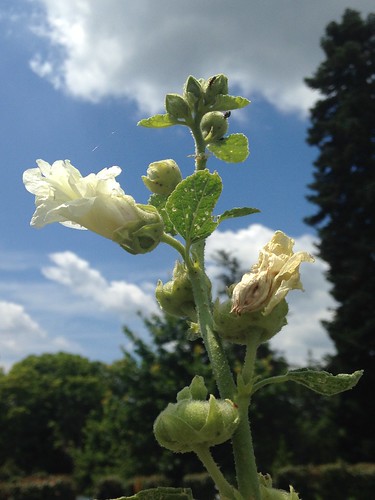
White Hollyhock, Springhill Road. Photo by Bob Kirchman
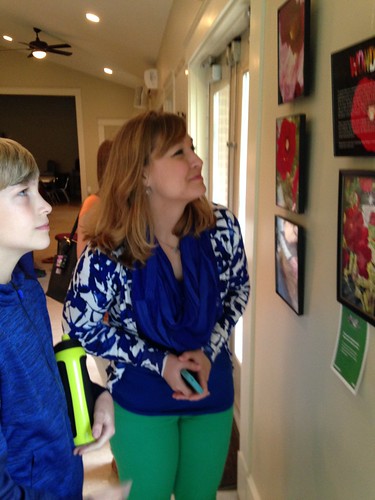
The Great-great Grandchildren of Mrs. Landes and the story of her legacy of hollyhocks. Her hollyhocks still bloom every Summer on Springhill Road in Staunton, Virginia. Her house is long gone, replaced by a gas station but the flowers continue to bless those who pass that way. They were the inspiration for the mural: Heavenly Hollyhocks that Mr. Kirchman painted in Charlottesville, Virginia.
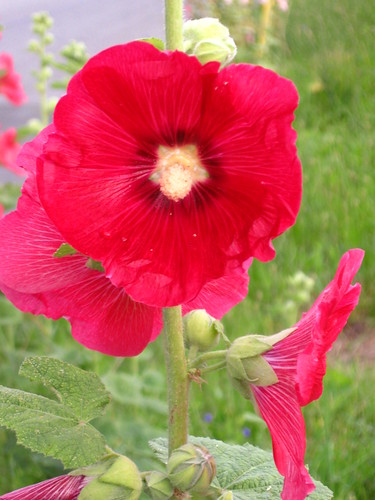
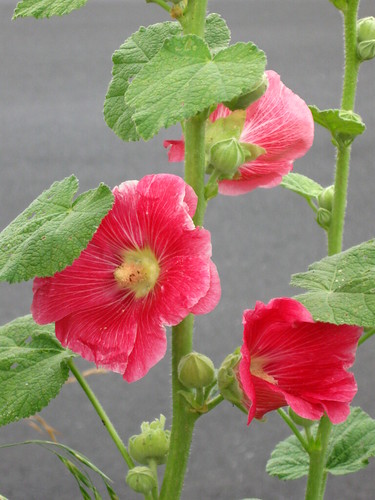
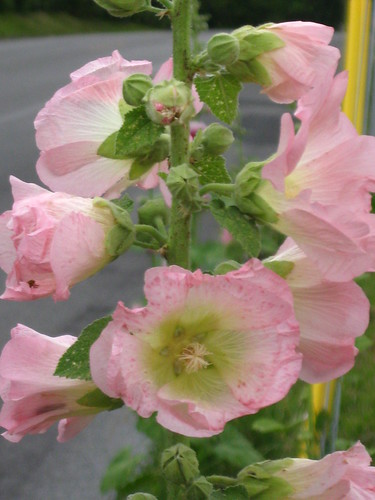
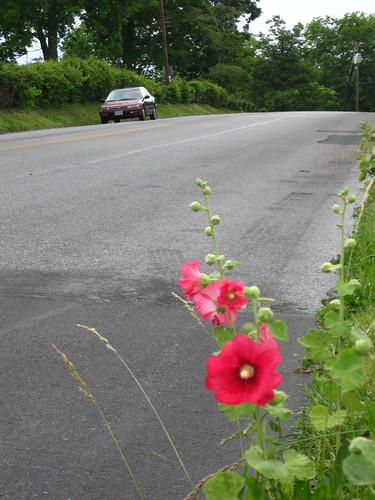
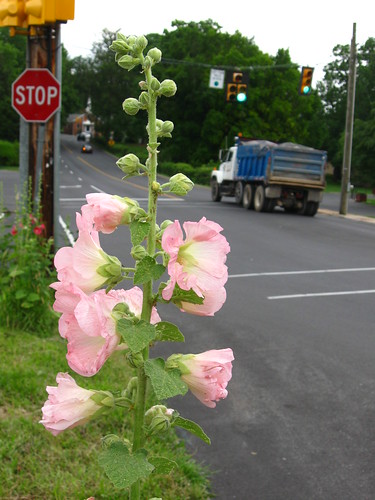
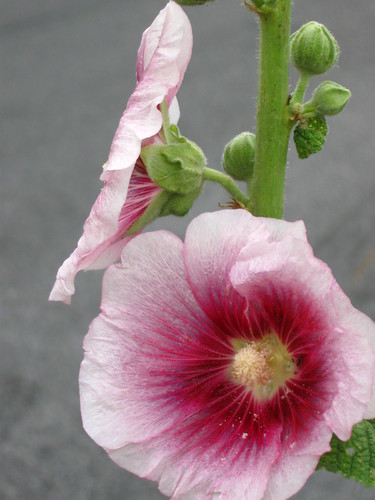
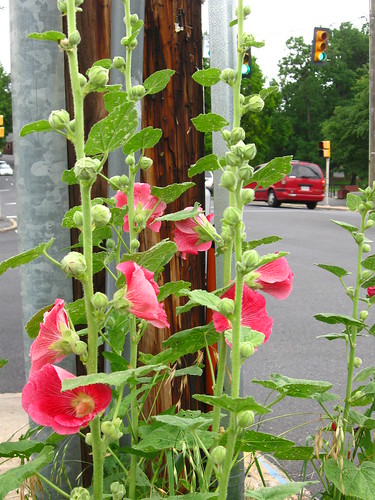
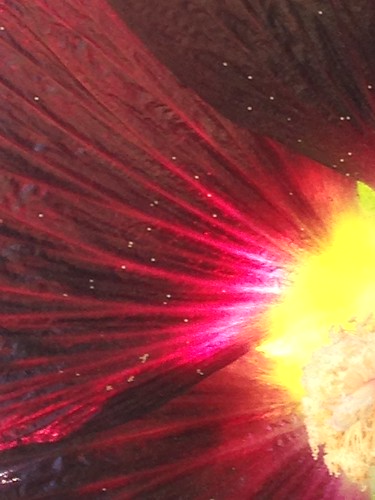
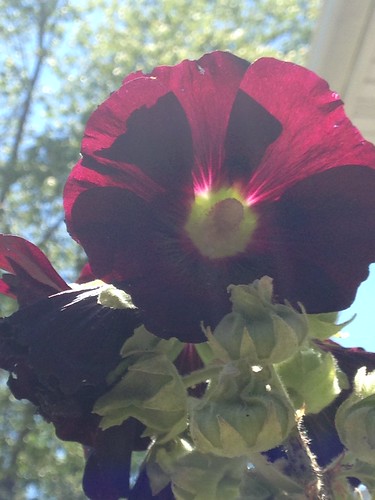
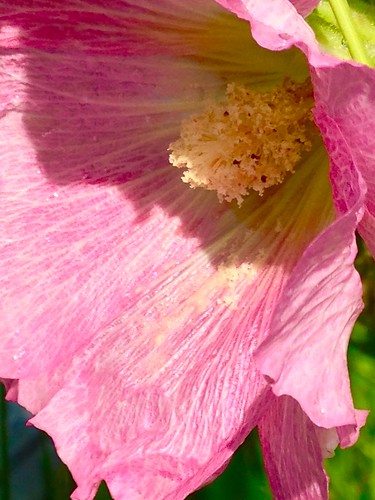
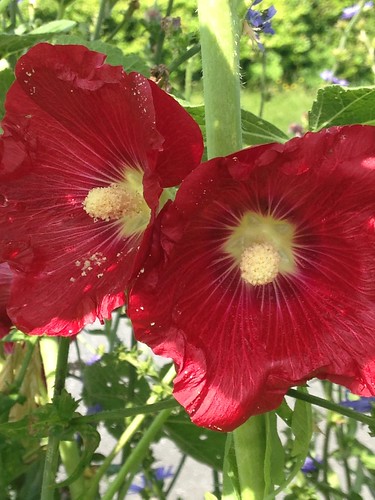
Every Summer they appear!, remnants of a garden planted long ago that continue to brighten the drive into Staunton along Churchville Avenue. What a great living legacy for a gardener!Photos by Bob Kirchman
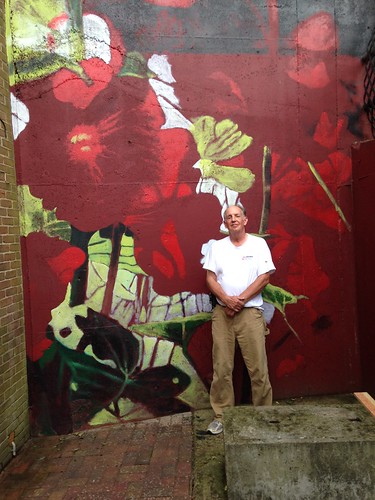
Mural inspired by the Springhill Hollyhocks.
Zipporah’s Flowers
As we were finishing the Journey to Jesus Mural, an Egyptian woman visited our church. Her name was Zipporah (the same as Moses’ wife). She mentioned that she had had dreams or visions of Heaven. Naturally I was intrigued and when I met her in the foyer I asked her to describe what she had seen. “Jesus is in Heaven surrounded by Children,” she remarked. That was a “WOW” moment. The Journey to Jesus Mural depicts children of all nations coming to the throne of the Redeemer! Zipporah unknowingly was affirming the message of a two-year project that she had no prior knowledge of.
She continued: “The flowers there are ENORMOUS… more like TREES!” Zipporah had unwittingly planted the seeds for the concepts developed in Heaven’s Hollyhocks and Elysian Lilys. These visions had comforted a Christian lady living in the midst of persecution in her homeland and now they had a message of comfort for others as well. That prompted their introduction into stark urban environments.


Journey to Jesus, a mural depicting the nations coming to Jesus in the New Heaven and New Earth described in Revelation 21. Mural by Kristina Elaine Greer and Bob Kirchman

Concept for a World's Fair Pavilion: Reproduction of Journey to Jesus.
Epic of Human Civilization
In 1932 the Trustees of Dartmouth College commissioned José Clemente Orozco,’s mural: The Epic of American Civilization, which depicts the history of the Americas. It is a great work of art but it presents a dark scenario ending with ‘gods of the modern world.’ It uplifts the great civilizations of the Maya and the Aztec but then delves into a rather dystopian depiction of modern times. Unseen is the fact that human civilization has never been without troubles and it is easy to see visions of the past as ‘pure’ forms because you are spared the sights and smells of everyday life there. Orozco’s mural was originally seen as controversial but as the academy aligned itself more and more with Anticolonialism and Socialism, the mural became more of a statement of where they were intellectually.
Dartmouth had originally been founded to evangelize the native peoples of America, but as the academy began to adopt the view that Western culture was ‘nothing special,’ Orozco became the Leonardo of this new faith. Selective history always sees the sins of those one disagrees with and overlooks a lot of those of one agrees with. Yes, the Conquistadors were terrible. Modern education is indeed soulless and seeks to indoctrinate, as Orozco intimates in his depiction of ‘gods of the modern world,’ but the academy, having espoused a more Marxist philosophy, continues to suppress other thoughts (especially Christian thoughts). Witness the recent speech by Noah Riner where the student body president talked of how finely educated Dartmouth graduates had not all been noble in their subsequent lives.
Noah Riner, 21 — homeschooled son of a Baptist preacher, and now student body president at Dartmouth College — sparked national controversy with his September 20th convocation speech to incoming freshmen. In what is traditionally an immemorable speech, Riner maintained that character, not just intelligence and talent, must be the goal for true education. Dartmouth, Riner told his peers, has turned out a lot of very talented, very intelligent individuals. “But if all we get from this place is knowledge, we’ve missed something,” he reasoned — citing examples, both historic and recent, of Dartmouth alums whose credentials were impeccable, but whose character was proven to be greatly corrupt. Turning to raise the issue of New Orleans — the looting, violence, and rape in the aftermath of Hurricane Katrina — Riner clarified, “My purpose… isn’t to condemn just [the citizens of New Orleans], rather it’s to condemn all of us.” “The real problem in this world,” Riner argued, “is not lack of education [but] lack of character.” “[C]haracter,” he held, “is what you do when no one is looking, but I’m afraid to say all the things I’ve done when no one was looking.” He challenged his fellow students to be honest with themselves and with one another. “We have the same flaws as the individuals who pillaged New Orleans,” he said, affirming the truth of the universal sin nature. “Ours haven’t been given such free range, but they exist and are part of us all the same.” [3.]
Here Riner offered the message of Christ… the original message of Dartmouth, to the protest of the modern institution that Dartmouth had become.
So Journey to Jesus is subtitled ‘The Epic of Human Civilization,’ a nod to Orazco’s work, but also a continuation of Riner’s assertion that if institutions have failed us we need something more than an institution to save us. It is in that spirit that we offer Christ and ‘visions of Heaven’ as an alternative.
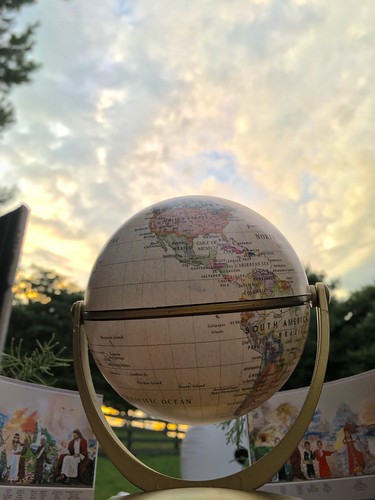
The BSB Corporation Pavilion at the 2019 Waynesboro World’s Fair. This was a FunDoodle Art Camp project where we built architectural models and photographed them against the sky to give them scale. The pavilion is a concept for an outdoor installation of the ‘Journey to Jesus ‘ Mural created by Kristina Elaine Greer and Bob Kirchman.
Harry Weese's Metro
Photos by Bob Kirchman
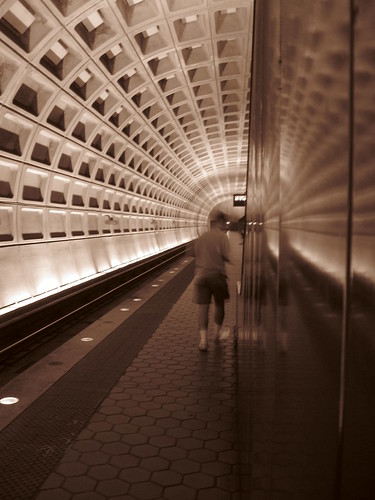
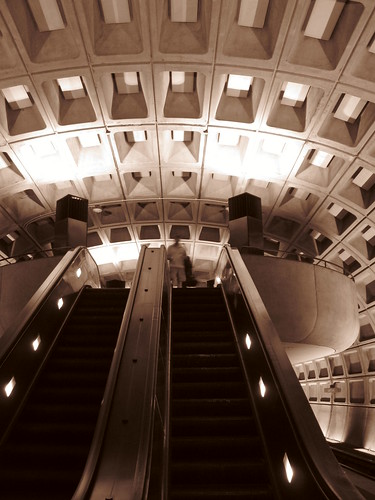
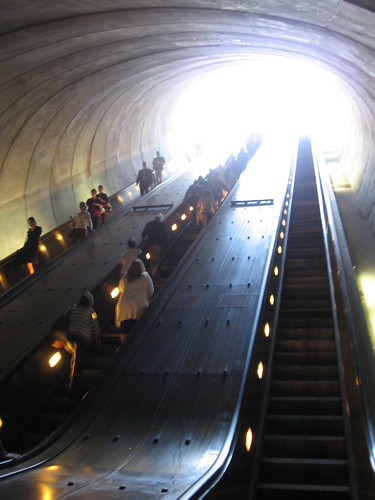
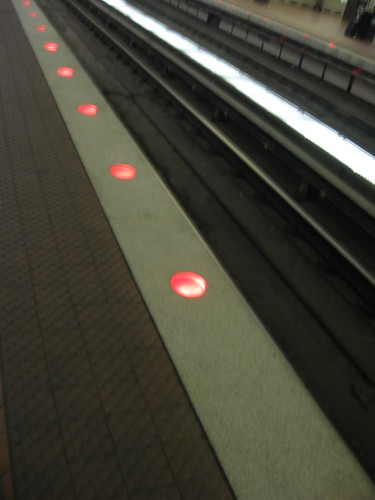
“No Safe Spaces II”
By Dennis Prager
[click to read]
Historically, colleges and universities were places dedicated to open dialogue and a free exchange of ideas. Sadly, intolerance and censorship toward conservatism is on the rise. On this special broadcast, Dr. Dobson talks with popular radio host Dennis Prager about his new documentary No Safe Spaces. Hear how free speech is under attack on campuses across the nation. (read more)
Dennis Prager is a nationally syndicated columnist, public speaker, and talk show host, broadcasting since 1982. He is the author of five books including Still the Best Hope, Why the Jews, and Happiness is a Serious Problem. He was a Fellow at Columbia University's School of International Affairs, where he did graduate work at the Middle East and Russian Institutes. He has taught Russian and Jewish history at Brooklyn College, and was appointed by President Ronald Reagan to the U.S. Delegation to the Vienna Review Conference on the Helsinki Accords. In 2011, Dennis co-founded Prager U, an institution of higher learning on the Internet.
In Search of the Perfect Burger
Sooner Barbeque in Stuarts Draft, Virginia

Longhorn cattle in Stuarts Draft, Virginia.
Number 17 was delicious. Brad Theodo, owner of Sooner Barbeque in Stuarts Draft, Virginia recently hosted a fundraiser for Risen Ridge Ministry, which offers horse related ministry to first responders (opening next year). Jen Beck, the visionary behind the ministry suggested I try the Draftburger. I was not disappointed! In fact, it was the kind of wonderful platter that food writers dream of! Grilled to perfection, and the beef is fresh!
How fresh? You ask. Well, the beef is local and Brad can even tell you the ‘name’ of your dinner. “Number 17” was indeed delicious – a longhorn from a farm right up the road. Of course the Barbeque is wonderful too. While I was sitting there, 40 pounds of pulled pork sailed out the door – headed for a catered event. Head down US 340 through Stuarts Draft and look for the cooker in front of the building. “You can’t miss it!”
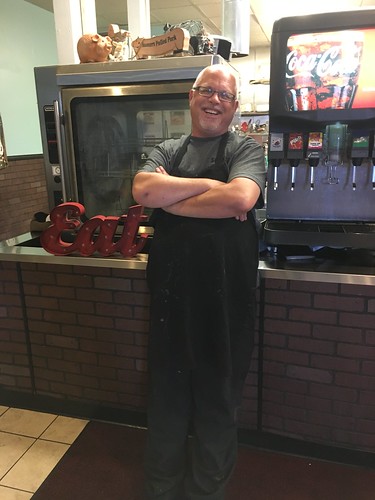
Brad Theodo.
Staunton's 'Unfinished' Mural
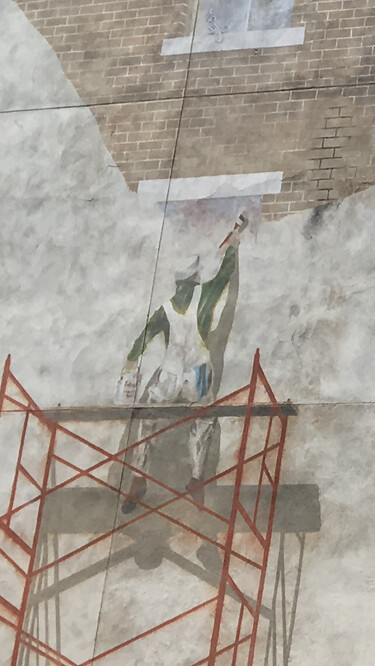
For 38 Years, the man on the scaffold has been painting the brick wall.
In the 1980s Staunton Revitalization Effort ran a competition to select a mural design for the wall of the Glassner Jeweler’s Building, which had been truncated to build access to the new parking garage. James Hanger III submitted the winning entry but the actual painting was done by Hugh Luck and Peter Freudenberg of Pine Street Studios. Here is where the story gets really interesting. Luck, at the time, worked for Peter Freudenberg. They later became business partners. In case you are unfamiliar with Freudenberg, he is the artist behind the ‘Peachoid’ in Gaffney, South Carolina. It is an enormous water tower that was created to look like a Brobdingnagian peach. Freudenberg carefully painted the water tower in realistic colors. Because of the unique cleft in the water tank, the sculpture sometimes receives a ‘bum rap,’ if you get my gist. Drivers on Interstate 85 enjoy it. Now you know that our city has a unique connection with it!
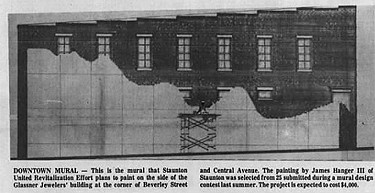
James Hanger III's original sketch for the mural. The budget for the project was estimated at $4000 ($11,644.63 in today's dollars)...

...and here is the completed mural when it was new.
Photo Courtesy of Hugh Luck.
Laney’s Palette Art Show
Saturday September 14th, 2019 in Crozet, VA
Works by Kristina Elaine Greer will be on display at the gallery space of Tabor Presbyterian Church, 5804 Tabor Street, Crozet, Virginia 22932. There will be an opening reception on Saturday, September 14th, 2019 from 1:00 to 4:00pm at the church. All are invited. The show will feature Laney’s Acrylic Paintings and Pencil Drawings from 2004 – 2019.
